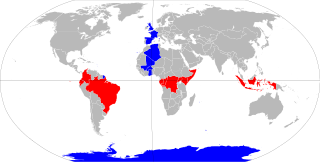The tactical diameter of a ship is the distance:
The ratio of the tactical diameter divided by the ship's length between perpendiculars gives a dimensionless parameter which can be used to compare ships maneuverability.

A circle is a shape consisting of all points in a plane that are at a given distance from a given point, the centre. The distance between any point of the circle and the centre is called the radius. The length of a line segment connecting two points on the circle and passing through the centre is called the diameter. A circle bounds a region of the plane called a disc.

In geometry, a diameter of a circle is any straight line segment that passes through the centre of the circle and whose endpoints lie on the circle. It can also be defined as the longest chord of the circle. Both definitions are also valid for the diameter of a sphere.

In geometry, two geometric objects are perpendicular if their intersection forms right angles at the point of intersection called a foot. The condition of perpendicularity may be represented graphically using the perpendicular symbol, ⟂. Perpendicular intersections can happen between two lines, between a line and a plane, and between two planes.

The MGM-140 Army Tactical Missile System is a supersonic tactical ballistic missile designed and manufactured by the US defense company Ling-Temco-Vought (LTV), and later Lockheed Martin through acquisitions.

A ricochet is a rebound, bounce, or skip off a surface, particularly in the case of a projectile. Most ricochets are caused by accident and while the force of the deflection decelerates the projectile, it can still be energetic and almost as dangerous as before the deflection. The possibility of ricochet is one of the reasons for the common firearms safety rule "Never shoot a bullet at a flat, hard surface." Ricochets can occur with any caliber, but short or round ricocheting bullets may not produce the audible whine caused by tumbling irregular shapes. Ricochets are a hazard of shooting because, for as long as they retain sufficient velocity, ricocheting bullets or bullet fragments may cause collateral damage to animals, objects, or even the person who fired the shot.

In mathematics, a semicircle is a one-dimensional locus of points that forms half of a circle. It is a circular arc that measures 180°. It only has one line of symmetry.

HMS Oberon was the lead ship of the Oberon-class submarines, operated by the Royal Navy.
A surface-to-surface missile (SSM) or ground-to-ground missile (GGM) is a missile designed to be launched from the ground or the sea and strike targets on land or at sea. They may be fired from hand-held or vehicle mounted devices, from fixed installations, or from a ship. They are often powered by a rocket engine or sometimes fired by an explosive charge, since the launching platform is typically stationary or moving slowly. They usually have fins and/or wings for lift and stability, although hyper-velocity or short-ranged missiles may use body lift or fly a ballistic trajectory. The first operational surface-to-surface missile was the V-1 flying bomb, it was powered by a pulsejet engine.

Length between perpendiculars is the length of a ship along the summer load line from the forward surface of the stem, or main bow perpendicular member, to the after surface of the sternpost, or main stern perpendicular member. When there is no sternpost, the centerline axis of the rudder stock is used as the aft end of the length between perpendiculars.

The Book of Lemmas or Book of Assumptions is a book attributed to Archimedes by Thābit ibn Qurra, though the authorship of the book is questionable. It consists of fifteen propositions (lemmas) on circles.

The equator is a circle of latitude that divides a spheroid, such as Earth, into the Northern and Southern hemispheres. On Earth, the Equator is an imaginary line located at 0 degrees latitude, about 40,075 km (24,901 mi) in circumference, halfway between the North and South poles. The term can also be used for any other celestial body that is roughly spherical.
PS Lily was a passenger paddle steamer operated by the London and North Western Railway from 1880 to 1900.

SS Violet was a passenger paddle steamer operated by the London and North Western Railway from 1880 to 1902.
Bulgaria was a 4,191 GRT cargo ship that was built as Empire Flamborough in 1945 by William Pickersgill & Sons Ltd, Sunderland, County Durham, United Kingdom for the Ministry of Transport (MoT). She was sold to Norway in 1946 and renamed Vindeggen. A further sale to Bulgaria in 1948 saw her renamed Bulgaria. She served until 1976 when she was scrapped.
Type 991 cable layer is a family of Chinese cable layers first saw service in Chinese navy, and later on, additional units also entered service with Chinese civilian authorities.
Empire Florizel was a 7,056 GRT cargo ship that was built in 1943 by Lithgows, Greenock, Renfrewshire, United Kingdom for the Ministry of War Transport (MoWT). She had a short career, being bombed and sunk during the Allied invasion of Sicily exactly three months after her launch.
M O P 223-C was a 2,588 GRT suction hopper dredger that was built in 1946 by William Simons & Co Ltd, Renfrew, United Kingdom as Empire Forager for the Ministry of War Transport (MoWT). She was sold in 1949 to the Argentinian Government and renamed M O P 229-C. She was renamed La Descanisada later that year and then renamed M O P 223-C in 1958, serving until she was scrapped in 1976.

The Chourre-class aircraft repair ship was a class of repair ships that were operated by the United States Navy during World War II.

SS M. H. De Young was an American Liberty ship built in 1943 for service in World War II. She was later acquired by the United States Navy and renamed USS Antelope (IX-109). Her namesake was M. H. de Young, an American journalist and businessman from 1865 to 1925.

SS John M. Clayton was an American Liberty ship built in 1942 for service in World War II. She was later acquired by the United States Navy and renamed USS Harcourt (IX-225). Her namesake was John M. Clayton, an American senator from 1853 to 1856.